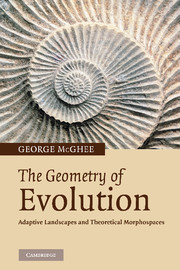Book contents
- Frontmatter
- Contents
- Preface
- 1 The concept of the adaptive landscape
- 2 Modelling natural selection in adaptive landscapes
- 3 Modelling evolutionary phenomena in adaptive landscapes
- 4 The concept of the theoretical morphospace
- 5 Analysing the role of adaptive evolution in theoretical morphospaces
- 6 Analysing evolutionary phenomena in theoretical morphospaces
- 7 Evolutionary constraint in theoretical morphospace
- 8 Evolutionary development in theoretical morphospace
- 9 There is much to be done …
- References
- Index
3 - Modelling evolutionary phenomena in adaptive landscapes
Published online by Cambridge University Press: 14 January 2010
- Frontmatter
- Contents
- Preface
- 1 The concept of the adaptive landscape
- 2 Modelling natural selection in adaptive landscapes
- 3 Modelling evolutionary phenomena in adaptive landscapes
- 4 The concept of the theoretical morphospace
- 5 Analysing the role of adaptive evolution in theoretical morphospaces
- 6 Analysing evolutionary phenomena in theoretical morphospaces
- 7 Evolutionary constraint in theoretical morphospace
- 8 Evolutionary development in theoretical morphospace
- 9 There is much to be done …
- References
- Index
Summary
Simpson (1944) boldly used an adaptive landscape to synthesize genetical and paleontological approaches to evolution … No visualization before or since 1944 has been so successful in integrating the major issues and themes in phenotypic evolution.
Arnold, Pfrender and Jones (2001, p. 9)Evolution in geological time
In the previous chapter we have seen that the adaptive landscape concept allows us to easily visualize and model the possible effects of natural selection in evolution through simple spatial relationships. As those models became more detailed, we began to encounter larger scale evolutionary phenomena, such as mass extinction and convergent evolution, that may involve thousands of species or operate across millions of years of time.
The first morphologist to use Sewall Wright's concept extensively to model evolutionary phenomena in adaptive landscapes was the palaeontologist George Gaylord Simpson in his classic books Tempo and Mode in Evolution (1944) and The Major Features of Evolution (1953). Wright's original concept was that of a fitness landscape; movement across that landscape involves changes in genotypic frequencies, small scale changes that are termed microevolution. Simpson made the conceptual jump from the fitness landscape of genotypes to the adaptive landscape of phenotypes, or morphologies, and the jump to large-scale evolutionary phenomena that operate on timescales of millions of years, or macroevolution. In this chapter we shall examine some of the large scale evolutionary phenomena that have been preserved in the fossil record of life, and to explore the possibility of modelling these patterns of evolution in adaptive landscapes.
Information
- Type
- Chapter
- Information
- The Geometry of EvolutionAdaptive Landscapes and Theoretical Morphospaces, pp. 31 - 56Publisher: Cambridge University PressPrint publication year: 2006
